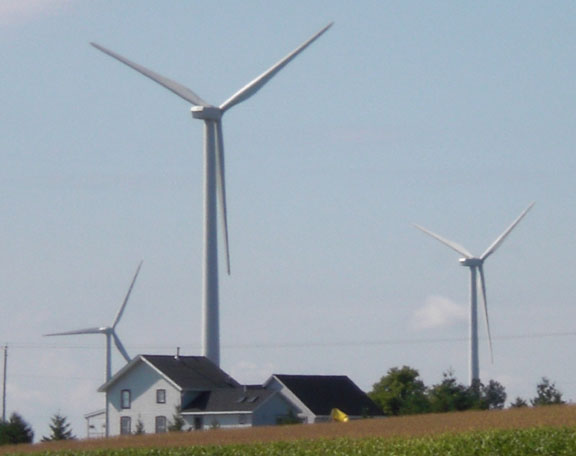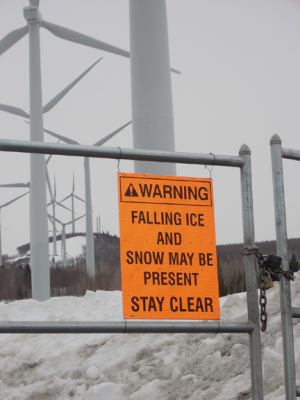RED ALERT WISCONSIN!
 This week, Wisconsin State Senator, Jeff Plale, (D-South Milwaukee) will introduce a bill which could hand over all siting of wind turbines to the Public Service Commission of Wisconsin.
This week, Wisconsin State Senator, Jeff Plale, (D-South Milwaukee) will introduce a bill which could hand over all siting of wind turbines to the Public Service Commission of Wisconsin.
The PSC approved the siting of industrial wind turbines just 1000 feet from homes in the wind farms of Fond du Lac County. Residents in those wind farms are now being forced to live with the disastrous result.
They are not alone. People all over the country are reporting the same problems. For a look at what life could be like for those of us unlucky enough to have our homes in a wind developer target area-- to see what the future could be for rural residents if Plale's bill passes, click on the link below to read a recent article called
Loud as the wind; Wind tower neighbors complain of noise fallout
While we wait for Senator Plale to introduce the bill that could bring the same kind of misery to the entire state, let's review our A to Z series.
If you're new to this issue, this series will give you good basic information about industrial windfarms and why communities need strong ordinances.
 This A to Z guide is based upon the Town of Union's Large Wind ordinance which was unanimously adopted in November 2008.
This A to Z guide is based upon the Town of Union's Large Wind ordinance which was unanimously adopted in November 2008.
The town of Union is located in Rock County, Wisconsin.
Thoroughly researched, and based in scientific and medical data, it's a product of 22 months of hard work by both citizens and elected officials, and over $40,000 in legal fees.
This solid, defensible ordinance is considered by many to be the best in the state. It's also an unusually readable ordinance, with all of the Study Committee findings right up front.
Click here to download the town of Union's entire 48 page ordinance.
A is for Assume: Click here if you'd like to know....
 Where did the siting guidelines used by the State of Wisconsin come from?
Where did the siting guidelines used by the State of Wisconsin come from?
What is the 1000 foot setback and the 50 decibel noise limit based on?
If wind turbine manufacturers require workers and operators to stay at least 1300 feet away from a spinning turbine, why does the state allow a 1000 foot setback?
If the World Health Organizations says that night time noise levels should be 35 decibels or less to allow for restful sleep, why does the state allow a noise limit of 50 decibels?
B is for Basics: Click here if you'd like to know......
 How big are industrial scale turbines?
How big are industrial scale turbines?
Why do we need a minimum setback of 2640 feet from our homes?
What is Shadow Flicker?
What is Ice Throw?
Who do you complain to about noise and other problems once the turbines are up?
C is for Construction: Click here if you'd like to know...
-about inevitable road damage during the construction phase, and what your township needs to do to insure that the developer will restore your roads to pre-construction condition. Includes Photo Essay: heavy equipment involved in transport and construction of industrial wind turbines.
D is for Dear Legislator: Click here if you'd like to know.....
How to contact your senator and assembly person and find out how much they really know about this issue, and where they stand on turbine siting reform, and to let them know we need renewable energy plan that will not endanger our most important non-renewables: our health, our families, our homes and our land. Setbacks and noise limits are the issue here. 400 foot tall turbines sited 1000 feet from our homes is just too close.
E is for Explain: Click here if you'd like to know...
What the Public Service Commission tells us -- or more accurately doesn't tell us- about the basis for the state's 1000 foot setback, the 50 decibel noise limit-- and and other non-responses to questions in the open records request from the Town of Union. Out of 18 questions, why will the PSC answer only six?
F is for Flicker: Click here if you'd like to know...
What is wind turbine shadow flicker? What does it look like? Why is it a problem? Why do developers say it will not cause problems? Why are people who are now trying to live with it in Fond du Lac County going nuts?
G is for Ground Current: Click here if you'd like to know.....
What is ground current? What is stray voltage? Why does it matter to farmers? Though the issue of stray voltage is a contentious one, there is no getting around the fact industrial wind plants require hundreds of miles worth of electrical cable be trenched into the ground. This post has pictures of the trenching and the high voltage cables being laid into the ground without conduit. It also features an interview with a farmer whose cows and milk production began to suffer once the turbines went on line.
H is for Help! Click here if you'd like to know....
Why did Flight for Life tell the people of Fond du Lac County they couldn't land inside of the wind farm? One of the things you are forced to give up when a wind farm is sited in your community is Flight for Life emergency air transport: Read why emergency medical helicopters are no longer an option for those living inside of wind farms.
I is for Ice Throw: Click here if you'd like to know...
Turbine ice throw: What it is, why it's a problem, and why wind developers continue to insist it's can't happen. Except it has: video, news reports, pictures.
J is for Jursidiction: Click here if you'd like to know....
Why, in spite of what wind developers and lobbyists tell residents and members of town and county government, the state of Wisconsin does indeed allow towns and counties to restrict and regulate wind energy systems—(commonly known as wind farms) for reasons of human health and safety. The state also allows towns and counties to declare a moratorium on all aspects of wind energy systems construction in order to give the township or county time to work on creating a wind ordinance. This post charts the Town of Union's step by step legal process in the creation and adoption of their ordinance.
K is for Kamperman & James: Click here if you'd like to know....
About a siting guide for industrial wind turbines with a focus on reducing health effects due to turbine noise. Created by community noise experts, George W. Kamperman and Richard R. James, these findings were used by the Town of Union when creating their ordinance.
L is for Letters to Lepinski: Click here if you'd like to know.....
About Fond du Lac County residents who are experiencing trouble with turbine related noise, shadow flicker and other negative effects of living too close to turbines in the PSC approved wind farm they are forced to live in, and the letters sent to Public Service Commissioner Jim Lepinski.
The bitter tone of these letters reflects the general feeling of many residents in Dodge and Fond du Lac Counties who are now living with the results of the PSC's decision.
M is for Members of the Committee: Click here if you'd like to know
Who are the people that worked on the town of Union Study Wind Ordinance study committee, and why did they volunteer their time?
When a wind developer approaches your town board with the news that they plan on siting an industrial wind farm in your community, your local elected officials have two choices:
They can do nothing at all and allow the development to go forward with the wind developers setting the terms-or they can create an ordinance which protects the health, safety and welfare of residents and also protects the township roads from the inevitable damage that will occur during the turbine construction phase.
N is for Noise: Click here if you'd like to know
What it's like to live inside an industrial wind farm day by day: The Meyer family in Fond du Lac, Wisconsin, began keeping a noise log the day the turbines near their home went on line on March 3rd of 2008. This noise log gives us an idea of the trouble improperly sited turbines can bring to a family home.
O is for Operator's Manual: Click here if you'd like to know ...
Manufacturer Vesta's workers and operators manual safety recommendations, which clearly sets 1300 feet as minimum safety setback for operators and workers on 1.5 MW turbines. And these are the people with hard hats on. Given this, why does the state of Wisconsin ask residents to live even closer?
What it's like for a township to be strong-armed by wind developers who say the state is on their side: excerpts from a transcribed audio recording of the March 8, 2007, Town of Magnolia Planning and Zoning Commission meeting in Rock County, Wisconsin. Instead of speaking to the commissioners and members of the community directly, the wind developer has decided to have a lawyer do the talking for them.
Why you have to agree to a gag order, 24/7 access to your home, and giving your social security number to a wind developer before they will agree restore your reception after turbines go on line: a look at the contract people in Fond du Lac County have to sign just to get their TV reception back.
R is for Research, References and Readability: Part One: Click here if you'd like to know....
More about wind turbine noise, why it's a problem and what kind trouble a corn and soybean farmer began to suffer once the turbines near his farm went on line.
(Click here to see an interactive map of many of the proposed wind farm sites in Wisconsin)
R is for Research, References and Readability: Part Two : Click here if you'd like to know:
About the findings and the recitals in the Town of Union ordinanance, and the documents they are based on.
“Findings” are the results of an investigation, study or inquiry such as the one undertaken by the Town of Union study committee.
"Recitals" are an account of the steps the town of Union took in order to create its large ordinance.
S is for Sound: Click here if you'd like to know....
What is the difference between sound and noise? And when it comes to wind turbines, why does it matter?
S is also for Safety: Click here if you'd like to know....
What the medical community is now saying about the impact of industrial wind turbines on human health.
(Click here to watch a news segment about this issue)
S is for Setbacks: Click here if you'd like to know....
Why 1000 feet from your door is just too close. From the Town of Union Large Wind Ordinance:
"The closer people live to wind turbines, the more likely they will experience noise annoyance or develop adverse health effects from wind turbine noise"
T is for Turbine: Click here if you'd like to know...
About the anatomy of a 400 foot industrial wind turbine, below ground level: how deep does the foundation go? How much concrete and rebar is used? How much electrical cable? How much compaction and other damage happens to a farmer's field?
Why families in Iowa farm were asked to evacuate their homes when a turbine began spinning out of control.
What wind turbine construction looks like: A photo essay from bottom to top of an 40 story industrial-scale machine.
U is for Unsafe: Click here if you'd like to know...
How the State of Wisconsin failed to protect the people of the Town of Byron and others living inside of the PSC approved wind farms of Fond du Lac County.
V is for Vibroacoustic Disease: Click here if you'd like to know....
What is Vibroacoustic Disease (VAD), what does it have to do with the siting of industrial wind turbines and why isn't the state of Wisconsin paying attention?
W is for Wildlife: Click here if you'd like to know...
About the turbine bat kills near the Horicon marsh, what we now know about what is killing them, and a candid look at a "green job": how post-construction bat and bird mortality studies are being conducted along in Fond du Lac County's Forward Energy wind farm.
X is for FIX What's Broken: Click here if you'd like to know....
Why are these Johnsberg and Malone wind farm residents asking for help, and why do they feel no one is listening?
The wind developers and the PSC assured the people of Johnsburg and Marshfield that the turbines sited 1000 feet from their homes would not be loud enough to bother them or keep them up at night, that shadow flicker would not be a problem, that they would suffer no negative health effects, that there would be no impact on wildlife or property values for that matter.
Over a year later it's clear to residents of yet another PSC- approved Fond du Lac County wind farm that none of this is true.
Y is for Year and a Day: Click here if you want to know:
About a day by day account of what life has been like for a Wisconsin family living inside of a PSC approved wind farm for over a year.
Z is for Zero Regard for Residents Concerns: Click here if you want to know...
What the future will be like for Wisconsin if wind farm siting reform bill passes. Hang on to your hats.
Most of the documents used to create this ordinance are in the Town of Union's Final Report which you can download by clicking here.
(To read other ordinances from around the state, click here.)
(For a closer look on how the Union ordinace came to be, click here)